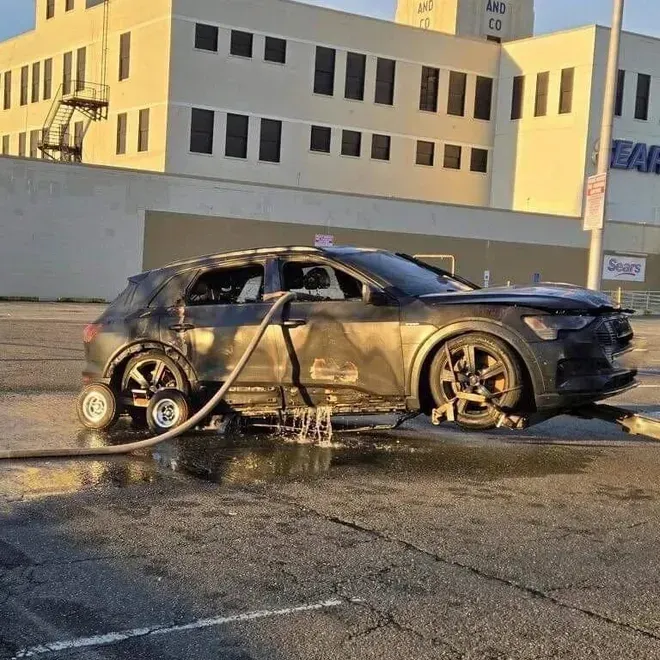In The News
Fire professionals raise alarm about EV lithium battery fire dangers, seek state guidance
Megan Burrow NorthJersey.com

When firefighters arrived at the scene of an activated smoke detector in a Hackensack parking garage one early morning in March, they began searching for the source of the smoke. Once they found the parked car on fire, they quickly knocked down the flames.
However, because the car was an electric vehicle, firefighters remained on the scene for more than seven hours, spraying thousands of gallons of water to cool down the battery to ensure it didn’t reignite.
“What happens in the battery, it goes into a thermal runaway — the battery just keeps generating its own heat,” Hackensack Fire Capt. Peter Rocco said. “It takes a long time to cool that down. We’re talking seven hours of an inch-and-¾ hose line just flowing water.”
The Hackensack fire highlighted what fire safety experts say has become a more urgent concern as electric vehicles have become more prevalent. While fires in electric vehicles are relatively rare compared with conventional car fires, departments need specialized training, equipment and guidance on the best strategies to deal with them, experts said.
Fires in electric vehicles burn much hotter than those in conventional gas-powered cars and are more challenging to extinguish fully. The temperature of an electric vehicle fire can reach 5,000 degrees Fahrenheit, compared with 1,500 degrees in a gas-powered car fire.
The battery pack at the bottom of electric vehicles, just about 5 or 6 inches from the ground, is contained in a strong case made from titanium or a similar material and is designed to protect the battery, but it’s difficult for firefighters to reach and cool down during a fire.
Inside are thousands of lithium-ion cells that allow the battery to store energy. If a fire ignites, heat can continue to spread through the cells — a phenomenon called thermal runaway — and there is a danger of reignition hours after the fire appears to have been extinguished. “You get these reignition issues, where you think the battery fire is out, but it really isn’t,” said Glenn Corbett, a professor of fire science at John Jay College of Criminal Justice in Manhattan and a longtime volunteer firefighter in Waldwick. “Lithium batteries are everywhere. The fire service has to catch up — we have to figure out how do we deal with this. For the most part, there is no standardized process.”
Local fire departments have trained in recent years for battery fires and purchased specialized equipment to deal with them.
Englewood last year used a $12,000 grant from the state Attorney General’s Office to fund training on lithium-ion batteries. The department bought a special nozzle that fits under the car to help cool the battery, and a plug that disables a car’s electric system to use for accidents involving electric vehicles, said Jeff Kaplan, the Englewood fire chief.
“Like all new technologies, it is evolving, and we are learning new things every day,” he said.
Rocco said Hackensack is looking into purchasing additional equipment. “Our equipment is capable of handling these fires, but as more specialized equipment comes to market we’re keeping our eyes out,” he said.
Teaneck firefighters completed extensive training on electric vehicles in the past year, and the township has purchased an under-car nozzle, a disabling plug, and a foam chemical agent to help extinguish battery fires, said Township Manager Dean Kazinci.
When an electric vehicle fire occurs in a residential parking garage, like the one in the six-story Main Street apartment building in Hackensack, the confined space presents more challenges. Limited access and ventilation in those areas can hinder firefighters and increase the risk of the fire spreading to nearby cars or the apartments above, Rocco said. Corbett, who has for years advocated for stronger safety measures
concerning large, lightweight wood construction apartment buildings, said the potential combination of an electric battery fire and so-called “toothpick towers” could be disastrous if the fire were to spread.
“That does worry me that we’re going to have one of these EVs in a garage and have the fire spread to the building itself,” he said. “Then you’re dealing with a difficult-to-put-out fire, and once it gets into the wood structure, you have a whole other set of problems.”
Lithium batteries are found in dozens of everyday devices, including laptops, cameras, phones, electric bikes, scooters and hoverboards.
Lawmakers across the country are beginning to address safety concerns with new bills as lithium battery fires have made headlines in recent years.
New York City last year passed a law banning the sale or rental of e-bikes, scooters and batteries for devices that do not meet safety standards, after several deadly fires. In Maryland, a commission is planned
to study lithium-ion battery safety and make recommendations for standards and guidelines.
A bill introduced last year in the U.S. Senate would require the Consumer Product Safety Commission to issue a consumer product safety standard for rechargeable lithium-ion batteries used in micromobility devices, such as electric bicycles and scooters.
In New Jersey, bills introduced in 2022 in the state Assembly and Senate that would require training for firefighters and emergency medical technicians in responding to electric vehicle fires did not advance past committee meetings. Other bills pending in the state Legislature would require electric vehicle battery management plans and would establish a task force to study ways to safely store, reuse, recycle, and dispose of used electric vehicle batteries.
But fire safety experts say more needs to be done. There is little government oversight, particularly concerning uncertified, aftermarket replacement batteries sold online, Corbett said. “The federal government has really fallen far short of what they needed to have done before this became an issue,” he said. “We’re relying on the private sector to keep things safe. The government has an obligation to be proactive and shut down the import of these cheap batteries.”
Hackensack Mayor John Labrosse said that as electric vehicles and e-bikes become more common, municipalities are looking for guidance from the state on where vehicles and devices should be parked, and the best methods for fighting these fires. “It’s a problem, and we’re going to need some assistance from the state,” he said. “We need some guidance from the politicians in Trenton to keep everyone safe.”
In the meantime, firefighters have developed various strategies to deal with these challenges. In Paramus, a group of four volunteer firefighters invented a device that slides under vehicles to extinguish battery fires more effectively, after seeing a series of news stories on a TV in the firehouse about electric vehicle fires happening around the country.
The ways many of the fires were being dealt with — using giant tubs to submerge the bottom of the car and cool the battery, or jacking a car on its side while firefighters spray the battery directly — were inefficient or dangerous, said Paramus Firefighter John Tabor, one of the founders of JKKS Industries, the company behind the device.
The company designed a nozzle about 3 feet long, 6 inches wide and 2 inches off the ground that could deliver 600 gallons of water a minute onto the underside of a car, and could be operated safely by one person. They named the device the Rice Applicator, after Tim Rice, a Hackensack firefighter and a captain in the Paramus department who died of cancer in 2021 at age 42.
The device is one of several tools firefighters have come up with to fight these fires safely and effectively. A similar device called the “turtle fire system” was developed by a Jersey City firefighter to spray water directly on the battery pack.
The Paramus group is waiting for a patent for its device and has sold about 40 so far to fire departments in the area.
“The goal is to make the fire more manageable,” Tabor said. “We feel we’ve come up with the best solution to date. The ultimate solution is making lithium batteries safer, but until they change how these batteries are built, we’re going to be facing these challenges.”
Want To Find Out How To Get a
RICE APPLICATOR?
Complete Form for More Information
Copyright 2024 JKKS Industries | Website Developed & Maintained by Local Mojo
